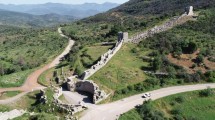Conclusions
-
1.
Some types of residual deformation of dam slopes made of coarse rubble under seismic action have no appreciable effect on their overall stability and reliability. Such deformations, permissible in assessing the seismic stability of a slope, are the rolling down of individual stones and the local sliding down of thin layers of material.
-
2.
We recommend that the stabilities of dam, slopes made of coarse rubble under seismic action should be calculated by means of the physically soundly based Eq. (2) or (4), derived on the basis of d’Alembert’s principle.
-
3.
Experiments in a tank and field observations at slopes of the Nurek and Charvak hydrostations confirmed the correctness of our theoretical postulates and experimental methods. To a first approximation, the friction coefficients obtained for gravels and stones may serve as a basis for calculating the stability of dam slopes made of coarse rubble under, seismic action.
-
4.
Our tank experiments and field observations showed that the coefficients of friction of coarse rubble of given rock moving as individual specimens or as a layer on the surface of a slope of given structure are mainly governed by the shapes of the specimens and the states of the surfaces of the specimens and of the slope, and also by the nature of the motion (rolling, sliding, etc.).
-
5.
The effect of the coarseness of the material on the value of the friction coefficient, is relative, and is felt only in those cases when variation of the grain size is accompanied by changes in the mechanical properties of the material (sand, gravel), or when the maximum dimensions of individual specimens are several times smaller than the maximum grain dimension of the material of the dam slope or base in the trough.
In conclusions we would remark that the results of the above experiments need refinement by further laboratory and field research, especially by work with large seismic platforms.
Similar content being viewed by others
Literature Cited
Building Norms and Rules [in Russian], Part II. Section A, Chapter 12, Building in Seismic Regions. Planning Norms (SNiP II-A, 12-62), Gosstroiizdat (1963).
S. N. Moiseev, “Seismic stability of earth and rubble dams”, Trudy Gidroproekta, Collection No. 10 (1963).
A. P. Sinitsyn, “Stability of dams made of local materials under seismic loads”, Inzhenernaya seismologiya, No. 1-2, Izdatel’stvo AN Tadzh. SSR (1964).
V. L. Kirpichev, Discussions on Mechanics [in Russian], Gos. izd-vo tekhniko-teoreticheskoi literatury (1950).
Technical Conditions and Norms for Design of Hydrotechnical Structures: Earth Dams [in Russian], Gosstroiizdat (1941).
V. G. Mel’nik, “Investigation of the seismic stability and deformability of dams made of local materials”, Material from Conference of Young Specialists, Tip. VNII VODGEO (1966).
Additional information
Translated from Gidrotekhnicheskoe Stroitel’stvo, No. 2, pp. 52–54, February, 1968.
Rights and permissions
About this article
Cite this article
Lushnov, N.P. Discussion on constructional norms. Hydrotechnical Construction 2, 168–171 (1968). https://doi.org/10.1007/BF02376286
Issue Date:
DOI: https://doi.org/10.1007/BF02376286




